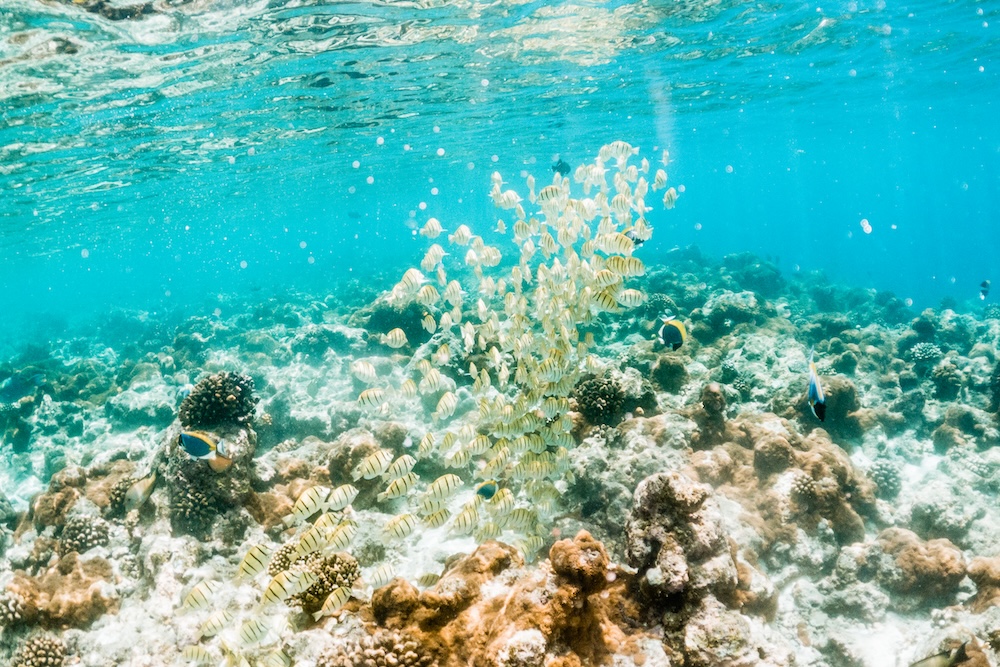Coral reefs are often described as vibrant underwater cities — teeming with life, color, and movement. But beneath the beauty lies a harsh biological truth: corals are living animals, and like all animals, they need to eat.
When ocean temperatures rise or pollution disrupts their delicate balance, corals lose their primary food source. They begin to starve, silently, even as they appear motionless to the human eye.
The Symbiosis That Feeds Coral
Each coral polyp hosts microscopic algae called zooxanthellae inside its tissue. These algae perform photosynthesis, turning sunlight and carbon dioxide into oxygen and sugars — energy that feeds the coral. In return, the coral provides the algae with shelter and nutrients.
It’s one of nature’s most elegant partnerships: a living exchange of light for life. Up to 90% of a coral’s energy can come from these symbiotic algae. The rest comes from plankton and organic matter that the coral captures with its tiny tentacles at night.
When that partnership breaks down, coral hunger begins.
What Happens During Bleaching
When the ocean warms even a few degrees above normal, corals become stressed. They expel their algae — the very organisms that feed them — in a desperate attempt to survive.
Without zooxanthellae, the coral turns white, exposing its calcium carbonate skeleton. This is known as bleaching.
Bleached corals aren’t immediately dead, but they are starving. With no algae to provide energy, they must rely entirely on catching food from the water — something they can’t do fast enough to meet their needs.
If warm or polluted conditions persist for too long, the coral’s energy reserves run out, and the colony dies.
The Physiology of Starvation
Starving corals show clear biological distress:
- They produce less mucus — a vital protective layer that shields them from disease.
- Their growth and reproduction stop.
- Their tissues thin as they consume stored lipids and proteins.
- Microbial infections take hold, accelerating tissue loss.
Scientists have observed that even a four-week bleaching event can cause permanent damage to coral metabolism. Repeated events are catastrophic.
Not All Coral Dies Right Away — But All Suffers
Some corals can temporarily survive by increasing heterotrophic feeding — catching more plankton and organic matter — but this only works in nutrient-rich waters. In clear tropical seas, where food is scarce, most corals cannot compensate.
Others recover if cooler temperatures return quickly and algae recolonize their tissues. But each bleaching event leaves them weaker, with less stored energy to withstand the next.
The ocean is warming faster than corals can adapt, turning temporary starvation into long-term decline.
What Coral Starvation Means for the Reef
When corals starve and die, the reef structure begins to crumble. Without living tissue to maintain it, the skeleton erodes. Algae and bacteria take over, changing the reef’s chemistry and depriving other species of oxygen and shelter.
Fish that depend on coral for food and habitat vanish. Invertebrates lose their breeding grounds. The intricate food web unravels — starting with one starving animal and ending with the loss of an entire ecosystem.
How Pollution Makes It Worse
Heat isn’t the only trigger for coral starvation. Chemical pollutants such as hydrocarbons, pesticides, and sunscreen compounds disrupt the coral-algae relationship even in cooler conditions.
When toxins interfere with photosynthesis or damage coral tissue, energy transfer breaks down. The coral may expel its algae or simply stop receiving enough nutrients to survive.
In other words, pollution can starve coral even without warming water.
Signs of Hope and Recovery
Some coral species show resilience — they can host different types of algae that tolerate higher temperatures, or they increase their feeding rates when stressed. Restoration efforts that reintroduce heat-tolerant strains of zooxanthellae show promise in helping corals rebuild their energy systems.
But even the most resilient corals need time, clean water, and stable temperatures to recover. Without those, starvation becomes irreversible.
What You Can Do
- Reduce your carbon footprint: less CO₂ means cooler oceans.
- Avoid reef-toxic sunscreens containing oxybenzone and octinoxate.
- Support reef restoration projects and marine protected areas.
- Cut single-use plastic and chemical waste that enter waterways.
- Share awareness: corals don’t just bleach — they go hungry.
Understanding that corals are living creatures capable of starvation transforms empathy into action.
FAQs
Do corals really eat?
Yes. They capture plankton and organic particles with their tentacles, but most of their energy comes from their symbiotic algae.
How long can corals survive without algae?
Depending on species and water quality, anywhere from a few weeks to several months — but energy reserves diminish quickly.
Can bleached corals recover?
If temperatures drop and algae return soon enough, yes. But frequent bleaching events leave them weaker each time.
Why is coral starvation important to understand?
Because it reframes coral bleaching not just as color loss, but as a biological famine — a process that reveals how climate change affects life on a cellular level.
Final Thoughts
Coral reefs aren’t dying in silence — they’re starving in slow motion. Each bleaching event is a hunger crisis beneath the waves, where once-vibrant life forms fade for lack of the energy they need to live.
To save coral reefs, we must give them back their food source: stable oceans, clean water, and the light of an unpolluted sky.
The cure for coral hunger begins on land — with the choices we make every day.









Reader Interactions